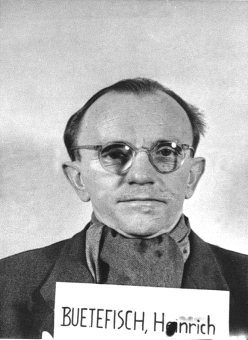Heinrich Bütefisch (1894–1969)

© National Archives, Washington, DC
Heinrich Bütefisch was born on February 24, 1894, in Hanover, where he went to school and began studying physical chemistry at the Technical University in 1911. In 1914, he volunteered for military service. After World War I, in 1919, he finished his studies and received a Ph.D. in 1920, writing a dissertation on phosgene, which had been employed as a poison gas in World War I (“On the Photochemical Kinetics of Phosgene Formation and a New Chlorine-sensitized Gas Reaction”). The same year, he started work as an analytical chemist for BASF and quickly ascended the career ladder: in 1930, he was made head of chemical production in Leuna.
In 1932, as ordered by Bosch, Bütefisch paid Hitler a call, to protest the defamation of I.G. Farben in the Nazi press. In 1936, as production commissioner for oil in the Armaments Ministry and a “military economy leader” (Wehrwirtschaftsführer), he became an associate of Carl Krauch in the Amt für Deutsche Roh- und Werkstoffe (Office of German Raw Materials), later renamed the Reichsamt für Wirtschaftsausbau (Reich Office of Economic Development), which was working on implementing the armament goals of the Four Year Plan. In 1937, Bütefisch became a reserve army lieutenant at the Heeresnachrichtenschule (Army Intelligence School), and one year later he was named a member of the management board of I.G. Farben AG. After that, he worked almost exclusively on developing synthetic fuels. In July 1937, he applied for NSDAP membership, which was granted and made retroactive to May 1, 1937 (Party number 5771136). In April 1939, he was admitted to membership in the SS, though his previous membership in a lodge of Freemasons caused him problems initially. In addition, he was a member of the Freundeskreis Reichsführer SS, the “Circle of Friends of Himmler.” In 1941, now holding the rank of SS-Sturmbannführer, he became head of the gasoline synthesis program to be established at the I.G. Auschwitz plant. According to his own statements, he was never present in the Buna/Monowitz concentration camp, and he knew the construction site only from a few visits. With the rank of SS-Obersturmbannführer and a holder of the Knight’s Cross of the War Merit Cross (Ritterkreuz des Kriegsverdienstkreuzes), he was arrested by the U.S. Army in 1945.
As the head of the fuel sector at I.G. Auschwitz and a member of the management board, Heinrich Bütefisch was sentenced in the I.G. Farben Trial at Nuremberg in 1948 to six years in prison, held responsible for slave labor done by concentration camp prisoners while building the I.G. Auschwitz plant. After his early release from prison in 1951, the following year Bütefisch became a member of several supervisory boards, including Deutsche Gasolin AG, Feldmühle, and Papier- und Zellstoffwerke AG. In addition, he had a consulting contract with Ruhrchemie AG Oberhausen, which was jointly owned by Hoechst and Mannesmann, and he was invited to join its supervisory board in 1952. In 1964, at the instigation of Hans Käding, a member of the management board of Ruhrchemie and a former employee of I.G. Farben, he was awarded the Great Cross of Merit (Großes Verdienstkreuz) of the Federal Republic of Germany; when protests ensued, Federal President Heinrich Lübke asked for the return of the award. In the first Frankfurt Auschwitz Trial, Bütefisch was examined as a witness and appeared ignorant of the proceedings in the Buna/Monowitz concentration camp.
(SP; transl. KL)
















